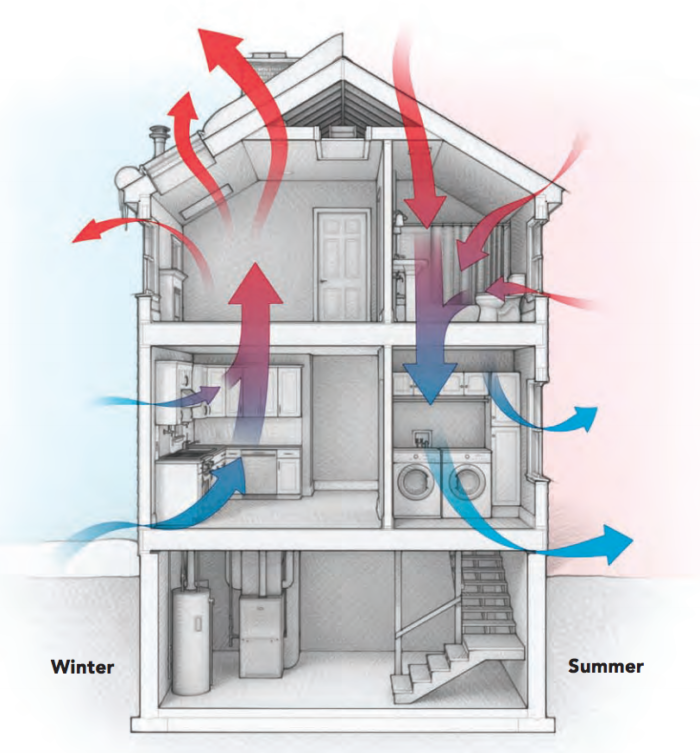Offices are not just places to work and earn but also have employees’ emotional attachment. Office buildings are the most

Space cooling makes up for 11% of total energy consumption in Los Angeles buildings with more than 50,000 ft2 of space. The majority of these systems get powered by electrical power. However, some of the larger buildings run absorption chillers run by district steam or natural gas. Only lighting, plug loads, and space heating absorb more energy than space cooling in Los Angeles.
About half of all structures in the multifamily residential sector use ineffective air conditioning systems. This makes an excellent opportunity to maximize the level of cooling efficiency in them.
Packaged terminal air conditioners (PTAC)
Through-the-wall air conditioners
Window-type air conditioners
… And that is that they require holes in the building envelope. This is not good at all, because it increases heat loss during the winter and heat gain during the summer. For that reason, these air conditioning units are not only ineffective, but they add to the load put on existing space heating systems.
The Los Angeles Urban Green Council predicted the yearly losses due to air leakages caused by these AC units. They estimated that the leakages are costing anywhere between $130 million to 180 million dollars. Additionally, carbon dioxide (CO2) emissions linked to this waste of energy are around 375,000 to 525,000 tons per year.
Space cooling systems in office structures are usually more effective. The most popular systems used in office structures today are electric chillers and direct expansion units. Both electric chillers and direct expansion units are more efficient than PTAC units, window units, and through-the-wall units.

Using centralized space cooling systems in multifamily buildings can be challenging to say the least. This is because the upgrade is a big hassle for tenants. Not to mention that it makes space cooling expenses more complicated. The cost to run a central AC system is hard to split evenly because usage tends to vary with the tenant. Besides, space cooling electricity is unable to be measured individually if the system puts out cool air or chilled water.
Additionally, individual space cooling systems offer better efficiency than PTAC units, through-the-wall units, and window-type units. Two of the best options are heat pumps and mini-split air conditioners.
Mini-split air conditioners get their name from the design of the system configuration. Internal evaporator units cool the indoor air, circulating it with a fan built-in to the unit, while an external condenser unit expels any heat. The two elements are just fastened with insulated refrigerant lines. This eliminates the big openings customary with older system configurations
The mini-split heat pumps that are available, offer reversible operation to provide space heating during the winter, and space cooling during the summer. Two pieces of equipment are then consolidated into one unit using this method. This makes an attractive upgrade for buildings currently utilizing ineffective space heating systems like electric resistance heaters.
The cooling performance of heat pumps and split-type air conditioning units are generally indicated by a measurement called SEER. (Seasonal Energy Efficiency Ratio) This is a ratio of cooling yield in British Thermal Units to electrical input in watt-hours. The SEER is comparable to miles per gallon in an automobile, where higher values interpret into lower operating costs. Another efficiency metric referred to as the Energy Efficiency Ratio (EER), has identical units.
The difference between the two is that the SEER reflects the entire cooling season, and the EER is for test conditions specified by the AHRI. (Air-Conditioning, Heating, and Refrigeration Institute) There is also a unit called the Heating Seasonal Performance Factor (HSPF) in heating units, which is a ratio of the heating output in British Thermal Units to electrical power input in watt-hours.
Mini-split systems hold an exceptional advantage in efficiency when compared to traditional electric cooling and heating options. If a window-type unit and a resistance heater get substituted with a heat pump producing a SEER of 18 and an HSPF of 9, you can expect a space cooling savings of 50% or higher. Then add on heat savings, which can be even higher. (over 60%)
Aside from delivering a higher cooling efficiency, mini-split systems also qualify for cash rebates from the Con Edison incentive program. The rebates from mini-split air conditioners are determined as follows:
Residential (Home)
SEER 18
EER 12
Single-zone: $100
Multi-zone: $65/zone
Residential (Home)
SEER 20
EER 13
Single-zone: $200
Multi-zone: $130/zone
Multi-family or Small Commercial
SEER 18
EER 12
$100/ton
Multi-family or Small Commercial
SEER 20
EER 13
$200/ton
In the case of mini-split heat pumps, the following incentives apply:
Residential (Home)
SEER 18
EER 12
HSPF 9
Single-zone: $150
Multi-zone: $100/zone
Residential (Home)
SEER 20
EER 13
HSPF 9
Single-zone: $300
Multi-zone: $200/zone
Multi-family or Commercial
SEER 18
EER 12
HSPF 9
$100/ton
Multi-family or Commercial
SEER 20
EER 13
HSPF 9
$200/ton
Rebates improve the cost of performance of air-conditioning upgrades. Since the upfront cost of the upgrade decreases, the amount of money that you get back on each dollar spent increases.
If AC units that cross walls or windows are substituted with mini-split units that do not, the cooling load is decreased due to the closing of large gaps in the building envelope. This upgrade makes an excellent opportunity to verify that there are no other leaks present. (especially around windows and doors.) This switch improves the energy savings that come with space cooling upgrades because the newly installed unit is not only more effective but it also carries a reduced load.
In buildings that utilize incandescent lighting, it is a possibility to decrease the cooling load by upgrading to LED lamps. Suppose that a 60-watt incandescent bulb is easily replaced by a 10-watt LED bulb. If you were to replace 10 of them, that would total 500 watts less of heat. This adds up to just above 1,700 BTU per hour.
Additionally, PTAC units, through-the-wall units, and window-type units all carry a common advantage with them in terms of performance. That is that they produce a steady supply of fresh air. Mini-split units are incapable of providing ventilation. This is due to their system configuration. Therefore it is critical to confirm that existing ventilation systems are adequate after removal of the previous AC unit. Ventilation systems are generally designed to run self-sufficiently. However, it is still recommended to obtain the help of an expert in the field, simply because poor ventilation can lead to health issues.
PTAC units, through-the-wall units, and window-type units are some of the least efficient systems. But ironically, they are the most regularly used systems in multifamily buildings in LA. Mini-split systems can help by reducing cooling expenses by up to 50% or more, while Con Edison incentives top that off, making them even more cost-effective. But with any upgrade to a building system, an evaluation from an expert engineering professional is always the best way to go. This helps you to accomplish the best results all around. Even high-efficiency space cooling systems can perform inadequately if not matched with the correct application.
About Author
InnoDez